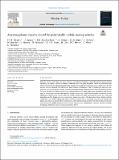Por favor, use este identificador para citar o enlazar a este item:
http://hdl.handle.net/10261/270189COMPARTIR / EXPORTAR:
 SHARE SHARE
 CORE
BASE CORE
BASE
|
|
| Visualizar otros formatos: MARC | Dublin Core | RDF | ORE | MODS | METS | DIDL | DATACITE | |

| Título: | Assessing plume impacts caused by polymetallic nodule mining vehicles |
Autor: | Weaver, P.P.E.; Aguzzi, Jacopo CSIC ORCID ; Boschen-Rose, R.E.; Colaço, Ana; De Stigter, Henko C.; Gollner, S.; Haeckel, M.; Hauton, C.; Helmons, R.; Jones, Daniel O.B.; Lily, H.; Mestre, N.C.; Mohn, Christian; Thomsen, Laurenz | Palabras clave: | Deep sea mining Plume impacts Best Available Technology Best Environmental Practice Biological tolerance Monitoring |
Fecha de publicación: | may-2022 | Editor: | Elsevier | Citación: | Marine Policy 139: 105011 (2022) | Resumen: | Deep-sea mining may be just a few years away and yet society is struggling to assess the positive aspects, such as increasing the supply of metals for battery production to fuel the green revolution, versus the potentially large environmental impacts. Mining of polymetallic (manganese) nodules from the deep ocean is likely to be the first mineral resource targeted and will involve direct impacts to hundreds of km2 of seabed per mine per year. However, the mining activity will also cause the generation of large sediment plumes that will spread away from the mine site and have both immediate and long-term effects over much wider areas. We discuss what the impacts of plumes generated near the seabed by mining vehicles may be and how they might be measured in such challenging environments. Several different mining vehicles are under development around the world and depending on their design some may create larger plumes than others. We discuss how these vehicles could be compared so that better engineering designs could be selected and to encourage innovation in dealing with plume generation and spread. These considerations will aid the International Seabed Authority (ISA) that has the task of regulating mining activities in much of the deep sea in its commitment to promote the Best Available Technology (BAT) and Best Environmental Practice (BEP) | Descripción: | 11 pages, 4 figures, 1 table | Versión del editor: | https://doi.org/10.1016/j.marpol.2022.105011 | URI: | http://hdl.handle.net/10261/270189 | DOI: | 10.1016/j.marpol.2022.105011 | Identificadores: | issn: 1872-9460 |
| Aparece en las colecciones: | (ICM) Artículos |
Ficheros en este ítem:
| Fichero | Descripción | Tamaño | Formato | |
|---|---|---|---|---|
| Weaver_et_al_2022.pdf | 4,91 MB | Adobe PDF |  Visualizar/Abrir |
CORE Recommender
SCOPUSTM
Citations
30
checked on 20-abr-2024
WEB OF SCIENCETM
Citations
25
checked on 24-feb-2024
Page view(s)
56
checked on 23-abr-2024
Download(s)
139
checked on 23-abr-2024
Google ScholarTM
Check
Altmetric
Altmetric
Este item está licenciado bajo una Licencia Creative Commons

